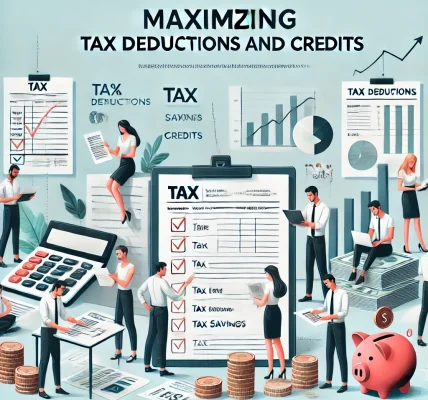Investing is one of the best ways to build wealth over time, but it’s important to be mindful of the tax implications that come with it. While most investment income is taxable, there are certain types of investments that are completely tax-free. These tax-free investments can provide significant advantages, particularly for those looking to minimize their tax liability while growing their wealth.
In this blog, we’ll explore what tax-free investments are, how they work, and why they can be a great addition to your portfolio for both long-term growth and tax savings.
1. What Are Tax-Free Investments?
Tax-free investments refer to investment instruments where the interest, dividends, or capital gains are not subject to income tax. This means that any returns generated from these investments are not taxed by the government, allowing investors to keep the full amount of their earnings.
These types of investments are highly attractive, especially for individuals in higher tax brackets or those seeking to maximize their returns without worrying about tax deductions eating into their gains.
2. Types of Tax-Free Investments
Here are some of the most common tax-free investment options available:
a) Tax-Free Bonds
Tax-free bonds are debt instruments issued by government-backed entities or public sector undertakings (PSUs). The interest earned on these bonds is exempt from income tax, making them an attractive option for investors seeking steady returns without the tax burden. Common examples include bonds issued by the National Highway Authority of India (NHAI), Rural Electrification Corporation (REC), and Indian Railways Finance Corporation (IRFC).
- Benefits: Provides stable, predictable income and tax-free interest.
- Suitability: Ideal for conservative investors looking for low-risk, tax-free returns.
b) Public Provident Fund (PPF)
The Public Provident Fund (PPF) is a government-backed savings scheme that offers both tax-free returns and a tax deduction under Section 80C of the Income Tax Act. The interest earned on PPF deposits is completely tax-free, and the maturity proceeds are also exempt from tax. PPF has a lock-in period of 15 years, making it an ideal long-term investment.
- Benefits: Tax-free interest, tax deduction under Section 80C, and low-risk investment.
- Suitability: Great for retirement planning and long-term savings.
c) National Savings Certificates (NSC)
National Savings Certificates (NSC) are issued by India Post and offer tax-free returns. The interest earned on NSC is taxable, but it qualifies for a deduction under Section 80C, making it an attractive option for those looking to reduce their taxable income while saving for the future. The maturity proceeds of NSCs are also tax-free.
- Benefits: Tax deduction under Section 80C, tax-free maturity amount.
- Suitability: Suitable for those looking for a low-risk, fixed-income investment with tax-saving benefits.
d) Municipal Bonds
Municipal bonds, issued by local government bodies, are another form of tax-free investment. The interest earned on municipal bonds is generally exempt from federal taxes and sometimes state taxes, depending on the location of the investor. Municipal bonds are typically used to fund local infrastructure projects, such as schools, highways, and hospitals.
- Benefits: Tax-free interest, relatively low-risk investment.
- Suitability: Good for investors in high tax brackets who are looking for steady income.
e) Tax-Free Government Schemes (E.g., Sukanya Samriddhi Yojana)
There are also government schemes designed specifically for certain groups, such as children or senior citizens, that offer tax-free returns. For example, the Sukanya Samriddhi Yojana, a government-backed savings scheme for the girl child, offers tax-free returns and deductions under Section 80C.
- Benefits: Tax-free returns, tax deductions, and social development focus.
- Suitability: Ideal for parents saving for their daughters’ education or marriage.
f) Tax-Free Life Insurance Policies
Certain life insurance policies offer tax-free returns. Under Section 10(10D) of the Income Tax Act, the proceeds from a life insurance policy (including maturity amount and death benefit) are tax-free in the hands of the policyholder, provided the premiums are within the prescribed limits.
- Benefits: Tax-free death benefits and maturity proceeds.
- Suitability: Suitable for those looking for life cover along with tax-saving benefits.
3. Why Are Tax-Free Investments Important?
Tax-free investments provide several key advantages for investors. Here’s why they’re worth considering:
a) Maximizing Returns
Since the returns from tax-free investments are not taxed, investors can keep the full amount of their earnings, which helps to maximize their overall returns. This is especially beneficial for long-term investors, as the compounding effect can work more efficiently without tax deductions eating into the growth.
b) Tax-Efficient Portfolio
Building a tax-efficient investment portfolio is key to growing wealth while minimizing the impact of taxes. Tax-free investments can be an important component of this strategy, helping you reduce your overall tax liability and allowing you to invest more of your earnings.
c) Ideal for High-Income Taxpayers
For individuals in higher tax brackets, tax-free investments can be an excellent way to reduce their effective tax rate. By diversifying into tax-free bonds or other tax-free assets, you can significantly reduce the amount of taxable income, thus keeping more money in your pocket.
d) Long-Term Wealth Building
Many tax-free investment options, such as PPF and Municipal Bonds, are long-term investments, making them perfect for those planning for retirement or other long-term financial goals. With consistent tax-free growth over the years, these investments can provide a substantial retirement fund or capital for future needs.
4. Tax-Free Investments and Their Suitability
When choosing tax-free investments, it’s essential to consider your risk tolerance, investment horizon, and financial goals. Here’s a breakdown of which tax-free investments might be suitable for different types of investors:
- Conservative Investors: Tax-free bonds, PPF, NSC, and Sukanya Samriddhi Yojana offer low-risk, stable returns, making them ideal for conservative investors.
- Retirement Savers: PPF, Sukanya Samriddhi Yojana, and tax-free life insurance policies are excellent for retirement planning, as they provide long-term benefits and tax-free returns.
- High-Income Earners: Municipal bonds and tax-free bonds offer tax-exempt income, which is perfect for individuals in higher tax brackets looking to reduce their overall tax burden.
5. Key Considerations When Investing in Tax-Free Investments
While tax-free investments offer great benefits, it’s important to keep the following points in mind:
- Lock-In Period: Many tax-free investments, such as PPF and Sukanya Samriddhi Yojana, have long lock-in periods. Ensure that the investment aligns with your financial goals.
- Lower Returns: Some tax-free investments may offer lower returns compared to taxable alternatives. Be sure to assess whether the tax savings compensate for the potentially lower yield.
- Investment Limitations: Certain tax-free investments come with limits on the maximum amount you can invest, such as the ₹1.5 lakh limit for PPF and NSC.
6. Conclusion
Tax-free investments offer a smart way to reduce your tax liability while still growing your wealth over time. By incorporating these investments into your portfolio, you can maximize your returns and build a tax-efficient strategy for the long term. Whether you’re saving for retirement, children’s education, or just looking to reduce your tax burden, tax-free investments like tax-free bonds, PPF, NSC, and municipal bonds can help you achieve your financial goals.




